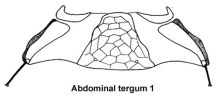 |
Scientific nameKarnyothrips flavipes (Jones, 1912)
Taxonomic positionThysanoptera: Tubulifera: Phlaeothripidae
SynonymsCryptothrips salicis Jones 1912, Haplothrips longisetis Bagnall 1913, Zygothrips pullus Hood & Williams 1915, Cryptothrips citri Watson 1918, Zygothrips
inermis Hood 1919, Haplothrips funki Watson 1920, Karynia [Sic!] weigeli Watson 1922, Haplothrips harnedi Watson 1922, Haplothrips oneco Watson 1924, Hindsiana catchingsi Watson 1924, Haplothrips cubensis Watson 1924, Watsoniella jonesianus
Coot 1950.
DiagnosisBody dark brown, tending to be blackish. Antennal segment I and II, V to VIII dark brown like body, III yellow at base and pale brown at apex, IV sometimes pale in basal 1/3. All femora brown; all tibiae pale brownish to yellow at apex. All tarsi yellow. Fore wing clear, unshaded. Body setae pale, anal setae dark. Head 1.2 times as long as broad. Dorsum of head weakly transverse lines of sculpture. Antennal segments III and IV with 1+1 and 1+2+1 sense cones respectively. Postocular setae well developed, expanded apically. Proboscis short and broad, apically rounded. Maxillary stylets long, at rest retracted far into the head, parallel to each other, interval from each other about 1/3 of head width. Maxillary bridge present. All dorsal prothroacic setae well developed, expanded apically, except anteromarginal seta which is reduced. Fore femur strongly developed, its width about 1/2 of the width of the head. Fore tarsus with stout, strongly curved tooth at inner apex. Fore wing with 1-5 duplicated cilia. Pelta triangular. Terga III-VII each with 2 pairs of sigmoid setae. Tube shorter than head. S1
setae on abdominal tergum IX expanded apically.
ImagesDistributionCosmopolitan. India (Delhi), America, Egypt, Cyprus, Pacific region, East Indies, Mediterranean Europe, Palestine, Egypt and Central Africa.
Hosts / PreyThis species is a predator of several species of Coccoidea (Asterolecanium spp., Parlatoria spp., Pseudaonidia duplex (Cockerell), Saissetia spp.), whiteflies and mites (Pitkin, 1976).
References
|


